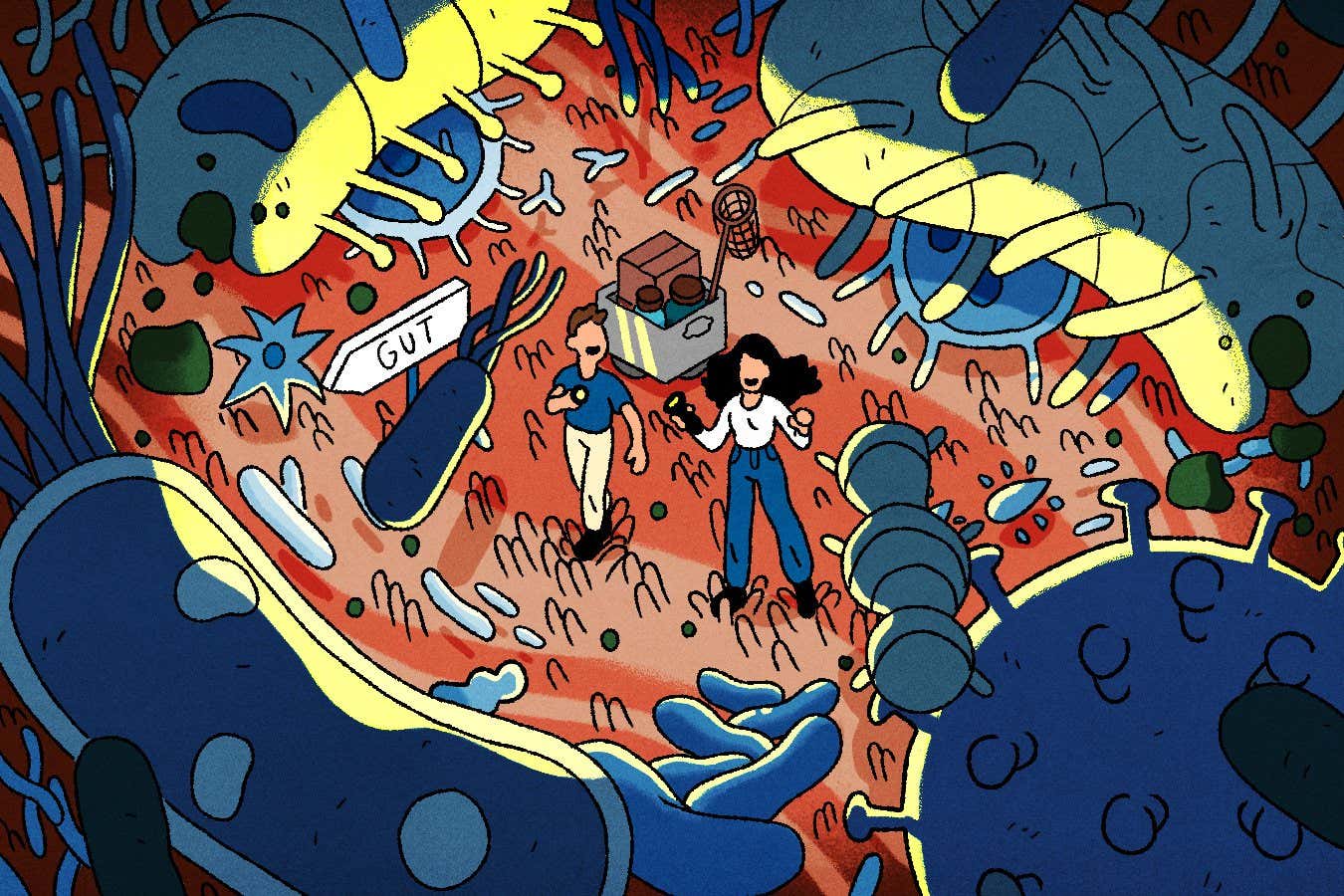Now Reading: The surprisingly big impact the small intestine has on your health
-
01
The surprisingly big impact the small intestine has on your health
The surprisingly big impact the small intestine has on your health


Jack Parsons
The US humorist Christopher Morley once described the human body as “an ingenious assembly of portable plumbing”. He wasn’t wrong: from our cardiovascular and lymphatic systems to our guts and urinary tract, a large proportion of our internal anatomy is dedicated to moving fluids around.
Perhaps the most impressive piece of plumbing is the gastrointestinal tract, which starts at the mouth and ends, 8 metres or so later, at the anus. In between are the oesophagus, stomach, small and large intestines and rectum. Together, they do a pretty impressive job of processing food, extracting nutrients from it and packaging up the waste for disposal.
But there is a lot more to the GI tract than that. We know, for example, that the microbiome in the large intestine is a key player in health and disease, and there is immense interest in how to maintain a healthy one. Now, it is the small intestine’s turn to take the spotlight. After decades in the shadow of the large intestine, it is finally revealing its secrets. It turns out that it, too, has crucial functions beyond processing food, including the maintenance of metabolic health. Is it time to start looking after our small intestines? And how might we go about this?
This body part is only “small” in the sense that it is much narrower than the large intestine, with a diameter of no more than 3 centimetres compared with 6 centimetres or more for the widest part of the colon. In terms of length, however, it is far from small, about 5 metres on average, coiled up in the abdomen like an unruly garden hose. It is divided into three functionally distinct sections: the duodenum, followed by the jejunum and ileum (see box).
The principal functions of the small intestine are the digestion and absorption of proteins, carbohydrates and fats. These processes take a relatively swift 3 to 6 hours, after which some 90 per cent of the nutrients have been extracted. The remainder – mostly water and indigestible fibre – enters the large intestine, where it will reside for a further 48 to 72 hours.
That much we have known for decades. But for a long time, the small intestine was infuriatingly resistant to further investigation, due to its inaccessible position between the stomach and the large intestine. Both of these are relatively easy to study and sample using probes and, in the latter’s case, stools. But getting into the small intestine, and retrieving anything from it, has always been difficult. “It’s been ignored,” says Gary Frost, who studies digestion at Imperial College London.
Duodenum
Partially digested food flows in from the stomach. Digestive enzymes and bile break down the molecules into smaller subunits
Jejunum
Main site of absorption of nutrients into the bloodstream
Ileum
Last section of the small intestine. Absorbs vitamins, reabsorbs bile acids and mops up most remaining nutrients. What is left then passes into the large intestine, or colon
More recently, however, that has changed. Around 20 years ago, it became clear that the small intestine also harbours a microbiome, though characterising it remained a challenge. Most samples came from post-mortems of people who had died suddenly or from individuals whose colon had been removed as part of their treatment for bowel cancer, and neither may be representative of the wider population. But in 2023, a team led by Oliver Fiehn at the University of California, Davis, developed swallowable probes that could gain access to the contents of the small intestine in healthy people.
Alongside that, researchers, including Frost, have developed techniques for placing tubes into specific locations in the small intestine for several hours at a time, allowing data to be collected as the digestive system goes about its business. These two techniques have opened the door to this hitherto-murky region of the gut, revealing that it isn’t just a long tube dedicated to the processing of food, but is also a highly dynamic organ involved in the regulation of metabolism and the maintenance of a healthy gut microbiome.
In an initial set of experiments, Fiehn’s team fed 15 volunteers four different capsules each. The capsules, which are about the size and shape of a large vitamin pill, are coated with a substance that dissolves at a given pH, activating a collection bladder that sucks in around 400 microlitres of liquid through a one-way valve. Because the pH of the small intestine rises gradually from as low as 4 in the duodenum to as high as 8 in the ileum, the probes can be programmed to open at specific locations and take snapshots of the gut contents. They are later retrieved from stools.
Fiehn’s team programmed the capsules to sample the three sections of the small intestine and the first part of the colon. Analysis of the contents showed that the microbiome of the small intestine is highly variable along its length, and very different from that found in the colon.
The small intestine’s microbiome
These experiments provided the first definitive evidence that we have been underestimating the small intestine, even if things remain murky. “We still don’t know a huge amount about the small intestinal microbiome,” says Andrew Macpherson at the University of Bern in Switzerland, who recently described it as “terra incognita”. But the work of Fiehn’s team is an important starting point for properly understanding the entire gut microbiome, says Frost. “We divide things up and look at individual parts, but those individual parts only work in a certain way because they’re connected,” he says.
Other experiments are revealing that the small intestine is not just very variable along its length, but also over time, operating on a previously unknown, 24-hour cycle.
Each day, after the stomach empties for the last time and the muscular peristaltic waves that drive food through the gut cease, the ileocecal valve between the small and large intestines closes and partially digested food, or chyme, pools in the ileum. So, while the stomach, duodenum and jejunum are empty and inactive overnight, the ileum is full and busy. “It starts acting a bit like a little stomach,” says Frost. When the overnight fast is broken, peristalsis restarts, the valve re-opens and the chyme is swept into the large intestine.
We don’t yet know what this means for people who sleep and eat at irregular times, such as shift workers. Nor do we have a solid explanation for why the ileum retains chyme overnight, says Frost. It may be to give it more time to retrieve bile acids, which are secreted into the duodenum to emulsify fat and which are a precious resource that the body likes to recycle if possible.
Or it may have something to do with digesting fibre. By definition, this is the fraction of the diet that human enzymes can’t break down, and which we leave to our gut microbiome to deal with. The received wisdom was that fibre travels through the small intestine chemically intact, but thanks to the new investigative techniques, that is now known to be untrue. “That’s one of the old ideas,” says Karen Madsen, who researches the microbiome at the University of Alberta in Edmonton, Canada. “Absolutely, fibre is being digested throughout [the small intestine].”

We used to believe that fibre, found in beans and legumes among other foods, passed through the small intestine chemically intact. But we now know that isn’t true
Shutterstock/Piyaset
The amount of microscopic life starts small: the duodenum has just 1000 microbial cells per millilitre of chyme, which is 10 orders of magnitude lower than in the colon. But the density rises along the length of the small intestine, hitting 100 million microbial cells per millilitre in the ileum.
Sometimes, anyway. Overnight, the ileal microbiome blooms explosively, fuelled by nutrients in the chyme reservoir. But when the ileocecal valve reopens, these microbes are mostly expelled into the colon and their number plummets. Their fate in the colon is uncertain, but it probably involves death: the ileal environment is very different to that of the colon, being higher in pH and oxygen, and the make-up of the ileal microbiome is also very distinct.
Most of these microorganisms are derived from the oral microbiome, says Frost, which may be how the small intestinal microbiome is replenished every day. Colonic microbes also probably leak in, says Macpherson. “The small intestine is right next to the most densely populated microbial community on the planet, our colon,” he says. “Potentially, it can be repopulated from the colon, but we don’t really know to what extent this occurs.”
Leaky gut syndrome
The fact that the microbes in the small intestine can digest fibre is probably of physiological importance, says Frost – though exactly how isn’t yet clear. We know that, in the colon, microbial fermentation of fibre produces a class of molecules called short-chain fatty acids (SCFAs), which both remain in the colon and are absorbed into the bloodstream with knock-on benefits throughout the body.
Human metabolism can’t synthesise SCFAs, so we exploit the bacterial ones for a range of biological functions. One of these is to maintain the integrity of the colon wall, to prevent bacteria from breaching it and causing inflammation. So-called leaky gut syndrome is increasingly pointed to as a possible cause of the low-level and yet extremely damaging inflammation that creeps through our bodies as we age, and which is a direct cause of metabolic conditions such as obesity and type 2 diabetes.
The same may be true in the ileum, says Frost. “The barrier function of the small intestine is probably critical to a lot of pathology that we see in humans. The inflammatory responses you’re seeing are probably as much to do with the small intestine as they are to do with the large intestine.”
His research has shown that microbial fermentation products, including SCFAs, accumulate in the ileum overnight and then “drop like a stone” once the fast is broken. Their biological effects are unknown, he says, but it is plausible that the ileum retains chyme in order to repair its wall, which is thinner than the colon’s and coated with less mucus, and hence more vulnerable to bacterial invaders. “The mucous layer is extremely thin in the small intestine and the penetration of molecules is certainly much more effective than from the large intestine,” says Macpherson. The duodenum and jejunum also host microbiomes and these may be involved in maintaining barrier function too, he says.
In that respect, the jejunum has also recently delivered a major surprise. Its main function is to absorb nutrients into the bloodstream. But it turns out that it transports nutrients, especially glucose, in the opposite direction as well.
Once you get access to spaces where you’ve not been able to go before, a whole new world opens up before you
Ogawa Wataru at Kobe University in Japan and his colleagues were investigating the mechanism of action of metformin, a highly effective but biologically mysterious drug that helps people with type 2 diabetes control blood sugar levels. To their surprise, they discovered that people with type 2 diabetes excrete substantial amounts of glucose into their jejunum, and that taking metformin almost quadruples this flux. That may partly explain the drug’s effect, as excreting glucose out of the bloodstream lowers blood sugar.
But the researchers also found this glucose flux in people without type 2 diabetes, showing that it is a normal part of human physiology. The glucose is metabolised by the microbes in the jejunum and ileum. Ogawa thinks the glucose is feeding the gut microbes, which, in turn, promotes the production of SCFAs.

Crystals of the drug metformin, which helps people with type 2 diabetes control their blood sugar
ANTONIO ROMERO/SCIENCE PHOTO LIBRARY
Yet more evidence for the importance of maintaining a healthy small intestinal wall comes from another treatment for type 2 diabetes. Duodenal mucosal resurfacing involves applying heat to the inner surface of the upper part of the duodenum during an endoscopy, to strip away the lining. This then quickly regenerates, with remarkable effects on metabolism. A 2022 study found that 69 per cent of people with insulin-dependent type 2 diabetes who underwent the procedure and were also given diabetes medication could stop injecting insulin altogether.
Resurfacing has its roots in gastric bypass surgery, which involves reducing the stomach to a small pouch and attaching the lower half of the small intestine to it as an exit portal, meaning that barely any food enters the stomach, duodenum and the upper part of the jejunum. It causes people to lose weight because they literally can’t eat much. But it also has profound and almost instantaneous effects on metabolism: most people with type 2 diabetes who undergo the surgery quickly regain normal glucose control even before they lose any weight. Why this happens isn’t known.
Appetite suppressant
Resurfacing was developed to mimic the metabolic effects of a gastric bypass without radically rerouting the GI tract. “We now know the duodenum has a huge role in metabolic disease, because resurfacing has a very clear beneficial effect,” says Madsen, even if the mechanism behind it remains a mystery.
The small intestine also controls metabolism through the release of the appetite-suppressing hormones PYY and GLP-1, which are secreted by the ileum in response to the presence of food, especially fibre. These hormones were thought to be exclusively released in the colon, but recent research has shown that the ileum gets in there first. In fact, says Frost, the ileum starts secreting them within minutes of food hitting the stomach, which is up to an hour before it enters the small intestine. The signal for this isn’t known: it could be a hormone released by the stomach in response to food, or perhaps a signal from the brain. Finding out could lead to new appetite-suppressing therapies for obesity, says Frost.
This flurry of recent discoveries is probably only scratching the surface. “Once you get access to spaces where you’ve not been able to go before, a whole new world opens up before you,” says Frost. Fiehn’s team, for example, has done more work using its probes and has new results in the pipeline. Frost is focusing on how to optimise the release of appetite-suppressing hormones in the ileum, as well as characterising the sparse microbiome in the duodenum. “Some of these observations might seem a bit obscure, but hopefully they will lead to new understanding of how we work, and prevent some of the problems that we have,” he says.
In the meantime, says Frost, it would be judicious to begin cultivating your small intestinal microbiome. The bacteria down there are especially fond of two fibre molecules, stachyose and raffinose, which are abundant in legumes. “They are really important for the microbial community in the small intestine,” he says. It is high time we started looking after that long-neglected section of our portable plumbing.
Topics:























